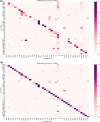Development of machine learning model for diagnostic disease prediction based on laboratory tests
- PMID: 33828178
- PMCID: PMC8026627
- DOI: 10.1038/s41598-021-87171-5
Development of machine learning model for diagnostic disease prediction based on laboratory tests
Abstract
The use of deep learning and machine learning (ML) in medical science is increasing, particularly in the visual, audio, and language data fields. We aimed to build a new optimized ensemble model by blending a DNN (deep neural network) model with two ML models for disease prediction using laboratory test results. 86 attributes (laboratory tests) were selected from datasets based on value counts, clinical importance-related features, and missing values. We collected sample datasets on 5145 cases, including 326,686 laboratory test results. We investigated a total of 39 specific diseases based on the International Classification of Diseases, 10th revision (ICD-10) codes. These datasets were used to construct light gradient boosting machine (LightGBM) and extreme gradient boosting (XGBoost) ML models and a DNN model using TensorFlow. The optimized ensemble model achieved an F1-score of 81% and prediction accuracy of 92% for the five most common diseases. The deep learning and ML models showed differences in predictive power and disease classification patterns. We used a confusion matrix and analyzed feature importance using the SHAP value method. Our new ML model achieved high efficiency of disease prediction through classification of diseases. This study will be useful in the prediction and diagnosis of diseases.
Conflict of interest statement
The authors declare no competing interests.
Figures




Similar articles
-
Deep learning assisted detection of glaucomatous optic neuropathy and potential designs for a generalizable model.PLoS One. 2020 May 14;15(5):e0233079. doi: 10.1371/journal.pone.0233079. eCollection 2020. PLoS One. 2020. PMID: 32407355 Free PMC article.
-
Use of extreme gradient boosting, light gradient boosting machine, and deep neural networks to evaluate the activity stage of extraocular muscles in thyroid-associated ophthalmopathy.Graefes Arch Clin Exp Ophthalmol. 2024 Jan;262(1):203-210. doi: 10.1007/s00417-023-06256-1. Epub 2023 Sep 29. Graefes Arch Clin Exp Ophthalmol. 2024. PMID: 37773288
-
Construction of machine learning diagnostic models for cardiovascular pan-disease based on blood routine and biochemical detection data.Cardiovasc Diabetol. 2024 Sep 28;23(1):351. doi: 10.1186/s12933-024-02439-0. Cardiovasc Diabetol. 2024. PMID: 39342281 Free PMC article.
-
Artificial intelligence: Deep learning in oncological radiomics and challenges of interpretability and data harmonization.Phys Med. 2021 Mar;83:108-121. doi: 10.1016/j.ejmp.2021.03.009. Epub 2021 Mar 22. Phys Med. 2021. PMID: 33765601 Review.
-
Machine Learning-Based Automated Diagnostic Systems Developed for Heart Failure Prediction Using Different Types of Data Modalities: A Systematic Review and Future Directions.Comput Math Methods Med. 2022 Feb 3;2022:9288452. doi: 10.1155/2022/9288452. eCollection 2022. Comput Math Methods Med. 2022. Retraction in: Comput Math Methods Med. 2023 Aug 9;2023:9849173. doi: 10.1155/2023/9849173. PMID: 35154361 Free PMC article. Retracted.
Cited by
-
Development and application of a machine learning-based predictive model for obstructive sleep apnea screening.Front Big Data. 2024 May 16;7:1353469. doi: 10.3389/fdata.2024.1353469. eCollection 2024. Front Big Data. 2024. PMID: 38817683 Free PMC article.
-
Plasma Biomarkers as Predictors of Progression to Dementia in Individuals with Mild Cognitive Impairment.J Alzheimers Dis. 2024;98(1):231-246. doi: 10.3233/JAD-230620. J Alzheimers Dis. 2024. PMID: 38393899 Free PMC article.
-
Construction and Application of a Traditional Chinese Medicine Syndrome Differentiation Model for Dysmenorrhea Based on Machine Learning.Comb Chem High Throughput Screen. 2025;28(4):664-674. doi: 10.2174/0113862073293191240212091028. Comb Chem High Throughput Screen. 2025. PMID: 38351686
-
Machine Learning-Based Hyperglycemia Prediction: Enhancing Risk Assessment in a Cohort of Undiagnosed Individuals.JMIRx Med. 2024 Sep 11;5:e56993. doi: 10.2196/56993. JMIRx Med. 2024. PMID: 39263921 Free PMC article.
-
Identification and Prediction of Chronic Diseases Using Machine Learning Approach.J Healthc Eng. 2022 Feb 25;2022:2826127. doi: 10.1155/2022/2826127. eCollection 2022. J Healthc Eng. 2022. PMID: 35251563 Free PMC article.
References
-
- Min S, Lee B, Yoon S. Deep learning in bioinformatics. Brief. Bioinform. 2017;18:851–869. - PubMed
Publication types
MeSH terms
LinkOut - more resources
Full Text Sources
Other Literature Sources
Medical

